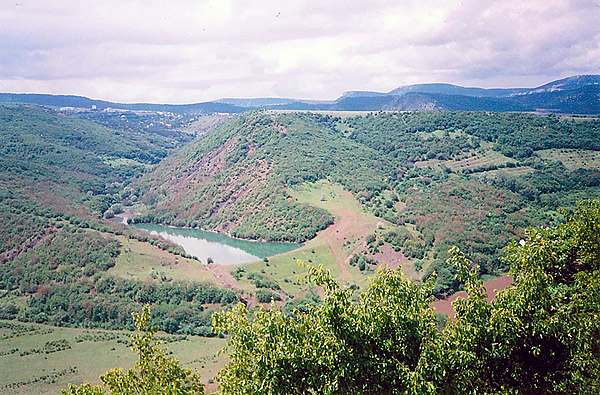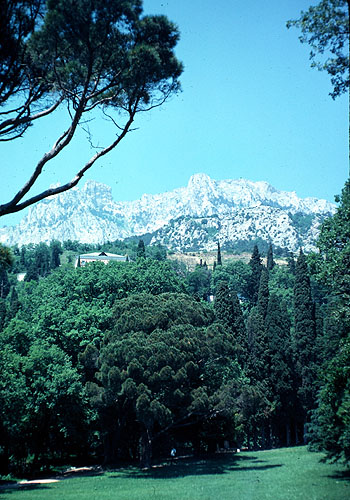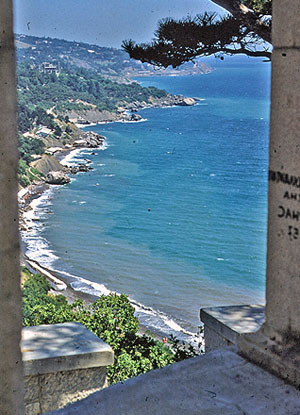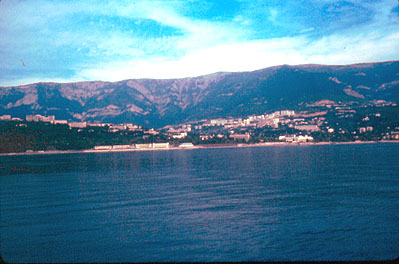
The Crimea (Крим, Крым) is the peninsula that juts out into the Black Sea from Ukraine. It connects to the Ukrainian mainland by a narrow strip of land (about 4 miles wide) called the Perekop Isthmus. At the eastern tip of the Crimea is the Kerch Peninsula, which is separated from the Russian mainland by the Strait of Kerch, anywhere from three to eleven miles wide.

Much of the interior of the Crimean peninsula is composed of dry steppe, while in the south mountains rise up to a height of about five thousand feet before dropping off sharply to the Black Sea.

Agriculture,
fishing, wine making and especially tourism provide
the mainstay of the Crimean economy. Health resorts, spas,
holiday get-away hotels and tourist facilities are
found all along the coastal areas of the Black Sea with its warm,
Mediterranean climate. The Crimean coast is sort of the Russian
version of the French "Riviera."


The Crimea in history:
- The peninsula has been occupied since ancient times and was the site of numerous Ancient Greek colonies.
- Technically
the Russians, during the reign of Catherine the Great, established their hegemony
over the peninsula in 1783 when they destroyed the Crimean Tatar
state. The Tatars originated as a Turkic people who reached the
Crimea in the early medieval period.
- During the Crimean War of 1853-1856, the Crimean Peninsula became
the primary site of military operations--there were other geographical
areas involved during the war--between the French and British, in
alliance with the Turks, against the Russians. The war had
started over competing claims to protection of certain Christian and
Orthodox Christian sites in the Near East (very bizarre). In October
1853 Turkey declared war on Russia; France and Britain
followed in March 1854. The war turned into a horrible exchange
of blunders and bad tactical mistakes on both sides, most famously
described in Alfred Lord Tennyson's poem, The Charge of the Light
Brigade, which occurred at Balaklava (Балаклава, Balıqlava)
on 25 October 1854 when British light cavalry attacked a strongly held Russian position with devastating results.
- During World War II, the Crimea was the scene of some of the bloodiest
battles of the Eastern Front, including the long siege of the city of Sevastopol.
- Deportation
of the Crimean Tatars. After the Soviet Army had recaptured the
Crimea from the Germans, on 18 May 1944, Stalin ordered the forcible
deportation of the entire population of Crimean Tatars from the Crimea
to Central Asia on the false grounds that they had collaborated with the
Nazis during the occupation of the Crimean--in fact, tens of
thousands of Tatars had been sent to labor camps in Germany by the
Nazis. This is called the "Sürgün" by the Tatars. Perhaps as
many as three hundred thousand were exiled with somewhere around forty to fifty percent dying.
- In February 1945, Stalin, Roosevelt and Churchill met in the Crimea at the Yalta Conference
that decided the fate of postwar Europe. The decisions taken at
the conference are still being debated by historians today.
- After
World War II, in 1954, the Crimea became part of the Ukrainian Soviet
Republic. Then in 1956 (and also in 1967), as a result of
Khrushchev's campaign against Stalin's cult of personality and the
ensuing policy of de-Stalinization, the
Crimean Tatars had their civic rights restored, but no formal actions were
undertaken to return them to their former home in the Crimea--many still remain in Uzbekistan,
but some have returned.
- Balaklava, the site of the Charge of the Light Brigade, became an underground, highly secret, supposedly impregnable-to-nuclear-attack, submarine
base that was operational until the end of the Soviet Union.
